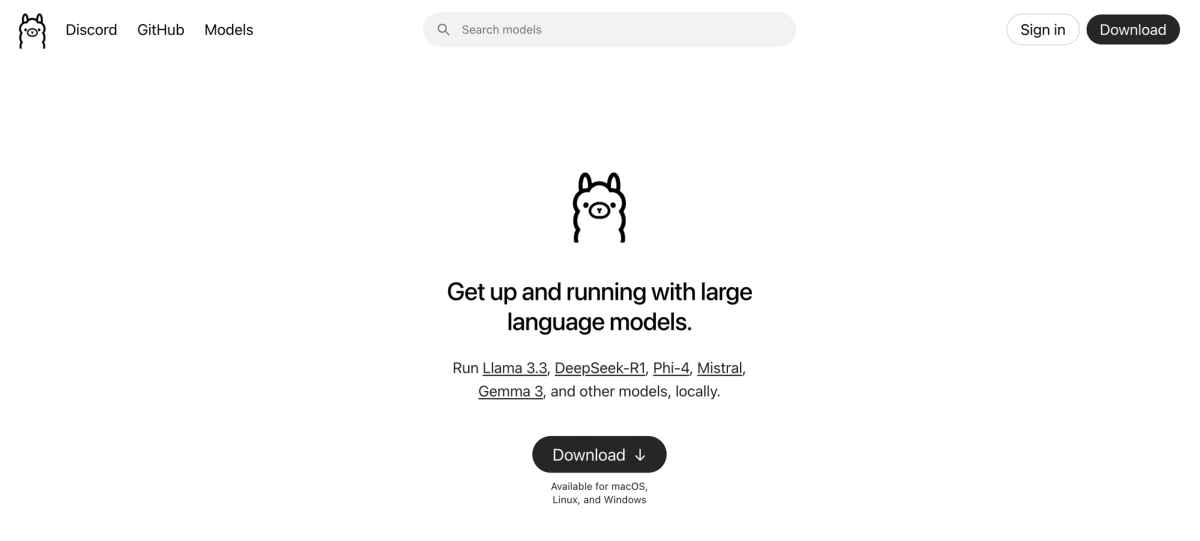Scaling AI with Ollama and the Power of Local Inference
Published on Jun 12, 2025
Get Started
Fast, scalable, pay-per-token APIs for the top frontier models like DeepSeek V3 and Llama 3.3. Fully OpenAI-compatible. Set up in minutes. Scale forever.
How do you choose the right AI model when you build an AI app? Most likely, you want a model that performs well and runs efficiently. This is especially true if your application is for a business or organization. An AI model that delivers fast inference times means your users will enjoy a seamless experience. And if your application can run the model locally instead of relying on costly cloud resources, you might save a lot of money. But there’s more to it than that. Many people overlook the fact that AI models are like living organisms. They must be fed and maintained, and their performance will change over time as they process real-world data. To keep your users happy, you need to ensure that the model you choose can deliver reliable performance both now and into the future. This article will explore how Ollama inference engine can help you meet your goals.
AI inference APIs are a valuable tool for achieving objectives such as fast, cost-efficient, and scalable AI inference. You can do this while controlling your models and data and without expensive cloud resources.
What is Ollama and its Key Features?

Ollama is an open-source tool that runs large language models (LLMs) directly on a local machine. This makes it particularly appealing to AI developers, researchers, and businesses concerned with data control and privacy.
Leveraging local resources, the Ollama model provides cutting-edge LLM capabilities while addressing the need for security, privacy, and independence from cloud-based solutions. It focuses on giving users access to AI tools without needing external cloud infrastructure, ensuring that data never leaves their systems.
Ollama: Empowering Local AI with Privacy and Flexibility
Ollama's commitment to simplicity and privacy distinguishes it from other LLM platforms. By enabling LLMs to run locally, users gain full ownership of their data and can customize AI models based on their unique needs.
Ollama also provides a robust framework that integrates easily with existing development workflows, offering flexibility without sacrificing performance. Ollama is a valuable tool for industries where data privacy is paramount, such as healthcare, finance, and government. Its ability to function offline or within secure environments gives it a significant advantage in sectors where regulatory compliance is essential.
What are the Key Features of Ollama?
1. Local Deployment with Privacy Control
Ollama's standout feature is the ability to deploy LLMs locally. Unlike traditional cloud-based models, Ollama ensures all data processing happens within your environment.
This local-first approach grants unparalleled control over sensitive data, a vital aspect for organizations looking to avoid risks associated with sending data to external servers. Whether a personal project or a corporate application, Ollama empowers users to maintain complete oversight.
2. No Need for Cloud Resources
One of the main hurdles to adopting AI solutions is the reliance on cloud services, which can be costly and present potential security risks. Ollama AI eliminates this dependency by leveraging local hardware, making AI development accessible even to those with budget constraints or stringent security policies. This feature also reduces latency issues, allowing real-time interactions without the overhead of cloud communication.
3. Command-line and GUI Options
Ollama mainly operates through a command-line interface (CLI), giving you precise control over the models. The CLI allows quick commands to:
- Pull
- Run
- Manage
If you’re interested in a command-line approach, check out our Ollama CLI tutorial. Ollama also supports third-party graphical user interface (GUI) tools, such as Open WebUI, for those who prefer a more visual approach.
4. Flexibility and Customization
Flexibility is at the core of Ollama’s design. Users can fine-tune models to match their specific use cases:
- Language processing
- Customer service automation
- Personalized recommendations
The platform allows integration with existing tools and systems, making it easy to enhance workflows without re-engineering entire applications. The built-in customization options ensure that LLMs are optimized for each unique deployment.
5. Lightweight and Scalable
Despite its focus on local environments, Ollama is built to scale. It efficiently utilizes available resources, ensuring smooth performance even as the workload grows.
From individual developers working on small projects to large organizations handling extensive datasets, Ollama adapts seamlessly, providing the necessary scalability without requiring cloud infrastructure.
6. Multi-platform Support
Another standout feature of Ollama is its broad support for various platforms, including:
- MacOS
- Linux
- Windows
This cross-platform compatibility ensures you can easily integrate Ollama into your existing workflows, regardless of your preferred operating system. Note that Windows support is currently in preview.
Ollama’s compatibility with Linux lets you install it on a virtual private server (VPS). Compared to running Ollama on local machines, a VPS allows you to access and manage models remotely, ideal for larger-scale projects or team collaboration.
Related Reading
How Ollama Works and Available Models

Ollama processes AI models with a workflow designed for efficiency and speed.
- It creates an isolated environment for running large language models (LLMs) locally on your system. This prevents conflicts with other installed software and comes fully equipped with the necessary components for deploying AI models.
- It loads the model, including downloading the model weights and the pre-trained data it uses to function.
- It fetches configuration files that define how the model behaves and any necessary dependencies, which are libraries and tools that support the model’s execution.
Once an LLM is loaded, Ollama runs inference. This means you can interact with the model by entering prompts, and it will generate responses. Ollama enables optimizations that improve the model’s performance on your system.
Key Features of Ollama's Inference Engine
Ollama works best on discrete graphical processing unit (GPU) systems. While you can run it on CPU-integrated GPUs, using dedicated compatible GPUs instead, like those from NVIDIA or AMD, will reduce processing times and ensure smoother AI interactions. Here’s a simplified breakdown of the workflow:
- Choose an Open-Source LLM: Ollama is compatible with various open-source models, such as:
- Llama 3
- Mistral
- Phi-3
- Code Llama
- Gemma
- Define the Model Configuration (Optional): For advanced users, Ollama allows the customisation of the model’s behaviour through a Model file. This file can specify specific model versions, hardware acceleration options, and other configuration details.
- Run the LLM: Ollama provides user-friendly commands to create the container, download the model weights, and launch the LLM for interaction.
- Interact with the LLM: Once running, you can send prompts and requests to the LLM using Ollama’s libraries or a user interface (depending on the chosen model). The LLM will then process your input and generate responses.
Installing Ollama
Ollama is compatible with macOS, Linux, and Windows (preview). For Windows, ensure you have Windows 10 or a later version.
Visit the Ollama website to download the Windows version and follow the standard installation process. After installation, open a terminal or command prompt and type llama version to verify that Ollama is correctly installed.
Running a Model with Ollama
Now, let’s explore how to work with Ollama models:
- Load a Model: Use the CLI to load your desired model. Ollama run llama2
- Generate Text: After loading the model, generate text with: “write a poem on cat.”
Running Your First Model with Customization
Ollama provides a straightforward approach to running LLMs. Here’s a detailed breakdown of the process:
- Choose a Model: Browse the available open-source LLM options supported by Ollama. Consider factors like the model’s size, capabilities, and your specific needs.
- Create a Modelfile: If you want to customize the model configuration, create a Modelfile as per Ollama’s documentation (https://github.com/ollama/ollama). This file allows you to specify the model version, hardware acceleration options (if applicable), and other configuration details.
- Create the Model Container: Use the Ollama create command with the model name (and optionally, the path to your Modelfile) to initiate the container creation process. Ollama will download the necessary model weights and configure the environment. Ollama create model_name [-f path/to/Modelfile]
- Run the Model (optional): Once the container is created, use the Ollama run command with the model name to launch the LLM. Ollama run model_name
- Interact with the LLM: The specific method for interacting with the running LLM depends on the chosen model. Some models offer a command-line interface, while others require integration with Python libraries. Refer to the specific model’s documentation for detailed instructions. Here’s an example scenario using a hypothetical LLM that accepts prompts through a command-line interface: ollama prompt model_name “Write a poem about a cat.”
Available Models on Ollama
Ollama supports numerous ready-to-use and customizable large language models to meet your project’s specific requirements. Here are some of the most popular Ollama models:
Llama 3.2
Llama 3.2 is a versatile model for natural language processing (NLP) tasks, like text generation, summarization, and machine translation. Its ability to understand and generate human-like text makes it popular for developing chatbots, writing content, and building conversational AI systems.
You can fine-tune Llama 3.2 for specific industries and niche applications, such as customer service or product recommendations. With solid multilingual support, this model is also favored for building machine translation systems useful for global companies and multinational environments.
Mistral
Mistral handles code generation and large-scale data analysis, making it ideal for developers working on AI-driven coding platforms. Its pattern recognition capabilities enable it to tackle complex programming tasks, automate repetitive coding processes, and identify bugs.
Software developers and researchers can customize Mistral to generate code for different programming languages. Its data processing ability makes it helpful in managing large datasets in the finance, healthcare, and eCommerce sectors.
Code Llama
As the name suggests, Code Llama excels at programming-related tasks, such as writing and reviewing code. It automates coding workflows to boost the productivity of software developers and engineers.
Code Llama integrates well with existing development environments, and you can tweak it to understand different coding styles or programming languages. As a result, it can handle more complex projects, such as API development and system optimization.
LLaVA
LLaVA is a multimodal model capable of processing text and images, perfect for tasks requiring visual data interpretation. It’s primarily used to generate accurate image captions, answer visual questions, and enhance user experiences through combined text and image analysis.
E-commerce and digital marketing benefit from LLaVA to analyze product images and generate relevant content. Researchers can also adjust the model to interpret medical images, such as X-rays and MRIs.
Phi-3
Phi-3 is designed for scientific and research-based applications. Its training on extensive academic and research datasets makes it particularly useful for tasks like literature reviews, data summarization, and scientific analysis.
Medicine, biology, and environmental science researchers can fine-tune Phi-3 to quickly analyze and interpret large volumes of scientific literature, extract key insights, or summarize complex data. If you’re unsure which model to use, you can explore Ollama’s model library, which provides detailed information about each model, including installation instructions, supported use cases, and customization options.
Related Reading
Use Cases for Ollama and Benefits of Using It

Ollama helps developers create local AI chatbots that run on private servers instead of cloud infrastructures. This process offers a variety of advantages to businesses by improving AI chatbot performance, ensuring data privacy, and allowing for custom solutions tailored to meet specific needs.A transportation company could use Ollama to build a chatbot to answer customer questions about flight delays and cancellations. By creating this local solution, the company could keep all interactions private, avoid latency issues, and fine-tune the model to understand specific industry language.
Research Behind Closed Doors
Ollama also helps organizations conduct sensitive research without exposing their work to the outside world. Universities and data scientists can use Ollama to run large language models locally, allowing them to experiment with private datasets in secure environments and areas with limited or no internet access.For example, a team studying machine learning applications for healthcare could use Ollama to analyze medical literature while ensuring patient data privacy. They could even adapt existing models to help summarize relevant findings before exposing their research to the public.
Custom Solutions for Privacy-Focused AI Applications
Ollama is also well-suited for building privacy-focused AI applications that help organizations minimize risk when handling sensitive information. For example, a legal firm could use Ollama to develop an AI solution for contract analysis. Running the AI locally would help ensure that all client data remains private and that the firm can meet regulatory requirements for data protection.
Integrating Ollama into Existing Software Platforms
Ollama can easily integrate with existing software platforms, enabling businesses to build AI capabilities into their current systems. For example, a company using a content management system to run its website could integrate Ollama to:
- Improve content recommendations
- Automate editing processes
- Suggest personalized content
To engage users.
Another example includes integrating Ollama into customer relationship management systems to enhance automation and data analysis, ultimately improving decision-making and customer insights.
Why Choose Ollama? The Benefits of Local AI Solutions
Ollama provides several advantages over cloud-based AI solutions, particularly for users prioritizing privacy and cost efficiency. Here are some key benefits of running large language models locally with Ollama.
Enhanced Privacy and Data Security
Ollama keeps sensitive data on local machines, reducing the risk of exposure through third-party cloud providers. This is crucial for industries like:
- legal firms
- healthcare organizations
- financial institutions
Where data privacy is a top priority.
No Reliance on Cloud Services
Businesses maintain complete control over their infrastructure without relying on external cloud providers. This independence allows for greater scalability on local servers and ensures all data remains within the organization’s control.
Customization Flexibility
Ollama lets developers and researchers tweak models according to specific project requirements. This flexibility ensures better performance on tailored datasets, making it ideal for research or niche applications where a one-size-fits-all cloud solution may not be suitable.
Offline Access
Running AI models locally means you can work without internet access. This is especially useful in environments with limited connectivity or for projects requiring strict control over data flow.
Cost Savings
By eliminating the need for cloud infrastructure, you avoid recurring costs related to:
- Cloud storage
- Data transfer
- Usage fees
While cloud infrastructure may be convenient, running models offline can lead to significant long-term savings, particularly for projects with consistent, heavy usage.
Related Reading
Stepwise Guide to Start Ollama

You will need a few items to get started with Ollama. First, Ollama is currently available for Linux, macOS, and Windows operating systems. Again, a preview version for Windows has just been launched. Next, while Ollama offers a user-friendly interface, some comfort with basic command-line operations is helpful.
Downloading Ollama
To install Ollama on your computer, visit the official website. Once there, click on the download button corresponding to your operating system (Linux, macOS, or Windows). This will download the Ollama installation script.
Installing Ollama
After downloading the installation script, open a terminal window. (Windows users can skip this step.) Next, navigate to the directory where you saved the Ollama installation script (usually the Downloads folder). Depending on your operating system, use the following commands to grant the script execution permission and then run the installation:
For Linux, enter the commands
bash
chmod +x ollama_linux.sh
./ollama_linux.shFor macOS, enter the commands
bash
chmod +x ollama_macos.sh
./ollama_macos.shFor Windows, double-click the downloaded file and follow the on-screen instructions during the installation process.
Pull Your First Model (Optional)
Ollama allows you to run various open-source LLMs. Here, we'll use Llama 3 as an example. Use the following command to download the Llama 3 model: ```bashollama pull gemma``` Replace 'gemma' with the specific model name if desired. The Ollama library curates a diverse collection of LLMs, each with unique strengths and sizes. Some examples are as follows:
Llama 3 (8B, 70B)
- Phi-3 (3.8B)
- Mistral (7B)
- Neural Chat (7B)
- Starling (7B)
- Code Llama (7B)
- Llama 2 Uncensored (7B)
- LLaVA (7B)
- Gemma (2B, 7B)
- Solar (10.7B)
Run and Use the Model
Once you have a model downloaded, you can run it using the following command:
bashollama run <model_name>Output for command "ollama run phi3"``` Managing Your LLM Ecosystem with the Ollama CLI
The Ollama Command-line Interface (CLI) provides a range of functionalities to manage your LLM collection:
- Create Models: Craft new models from scratch using the ollama create command.
- Pull Pre-Trained Models: Access models from the Ollama library with ollama pull.
- Remove Unwanted Models: Free up space by deleting models using ollama rm.
- Copy Models: Duplicate existing models for further experimentation with ollama cp.
- Interacting with Models: The Power of ollama run.
We can also use ollama using python code as follows:
python
import ollama
response = ollama.chat(model='phi3', messages=[
{
'role': 'user',
'content': 'Why is the sky blue?',
},
])
print(response['message']['content']) Output
The sky appears blue due to a phenomenon called Rayleigh scattering. As sunlight enters Earth's atmosphere, it collides with molecules and small particles in the air. These interactions cause the light to scatter in different directions. Shorter wavelengths (blue and violet) are scattered more than longer wavelengths (red and yellow).
Nevertheless, our eyes are more sensitive to blue light, which is why we perceive the sky as predominantly blue during the daytime. Here's a simplified explanation:
- Sunlight travels in straight lines from its source—the sun.
- When this light encounters Earth's atmosphere, it collides with gas molecules and tiny particles (like dust or water droplets).
- These collisions cause the light to scatter throughout the sky; nevertheless, blue light is scattered more than other colors because of its shorter wavelengths.
- Our eyes receive this scattered light, giving us the impression that the sky appears blue most of the time.
- Note that the sky can appear different at sunrise and sunset when it takes on shades of red or orange due to the longer path through the atmosphere.
How to Run Ollama Locally
Installing Ollama is straightforward. It works on Mac, Windows, and Linux. For this guide, I’ll install Ollama on a Mac and run the Smollom2 model with 135 million parameters and a 271 MB file size. The Smollom2 model itself is 92 MB, making it one of the smallest models available. Smaller models are easier to run on local machines and can still perform helpful tasks.To install Ollama, navigate to the official Ollama download page. You can download the installer from that page or run the following command to get Ollama CLI installed on a Mac:
brew install ollamaThe command installs Ollama and all its related dependencies. If all goes well, you will see the commands end like this:
==> Summary🍺 /usr/local/Cellar/ollama/0.5.7: 20 files, 40.6MB
If you installed it with brew, you will need to run `ollama serve`. You will see the Ollama variables and resources. Then you can run `ollama --version` in a different CLI tab. You will see something like the following:
ollama --versionollama version is 0.5.7
At the time of writing, the latest version of Ollama is 0.5.7. Because Ollama was just installed, you won’t have any models. To check that, you can run `ollama list`, which will show an empty list.
Run the Smollom2 Model
To install and run the Smollom2 135 million parameter model, execute the following on your command line:
ollama run smollm2:135m
Depending on your internet speed to download the 271MB model will take some time and show you the following output, where you can type your first question or prompt to the model, like:Why is the sky blue? Give the shortest possible answer.
You can play around and send it prompts or questions like, Who are you? It will give the answers. If you write `/?` you will see the help menu as follows:
You can type in `/bye` to stop the running model and get out of its prompt. Congrats! You have successfully run a relatively minor LLM (pun intended) on your machine. As it is a smaller model with only 135 million parameters (271 MB), it may not perform well on many tasks. So in the next section, you will run the popular DeepSeek R1 8 billion parameter model.
Run the DeepSeek R1 Model
To run the DeepSeek R1 8 billion parameter model, you can run the following command:```ollama run deepseek-r1:8b```Keep in mind that you are downloading almost 4.9 GB of data, so depending on your internet speed, it may take minutes (or hours, I can’t say). With Ollama, you can try many open models, have a look at their models page, and choose which model you would like to run on your local machine.
Make sure that you have enough resources, memory, CPU, and disk space to run a really large model. For instance, the DeepSeek R1 671B parameters model is 404 GB, which will surely not run on a consumer-grade laptop.In my case, after a few minutes of waiting, the deepseek-r1:8b model was downloaded and it ran. You can run the same question or prompt of why is the sky blue? give the shortest possible answer and see the response from the model as seen below:
As you can see above, DeepSeek R1 (R for reasoning) apparently “thinks” and then gives back a response. That is something new. To stop the model and exit the chat, you can type `/bye` and then get back to the bash.
Where Does Ollama Store the Models?
Depending on your operating system and how you installed Ollama, it may vary. In my case, on a Mac, it was stored in the user directory at `~/.ollama/models`, as you can see below with the command:```ls -al ~/.ollama/models```
Ollama stores models at `~/.ollama/models`. Ollama stores the models at `~/.ollama/models` on Linux machines as well. It can be changed by setting an environment variable called `OLLAMA_MODELS`
Start Building with $10 in Free API Credits Today!
Inference delivers OpenAI-compatible serverless inference APIs for top open-source LLM models, offering developers the highest performance at the lowest cost in the market. Beyond standard inference, Inference provides specialized batch processing for large-scale async AI workloads and document extraction capabilities designed explicitly for RAG applications.
Start building with $10 in free API credits and experience state-of-the-art language models that balance cost-efficiency with high performance.





